Chapter 14: Pesticides Are Poison from the Hesperian.org health guide: A Community Guide to Environmental Health.
A flier created by the CDC's National Diabetes Education Program as a guide for patients in the management of medicines to treat diabetes. Available in English.
- Diabetes and You - All Medicines Matter.pdf (442.21 KB)
Diabetes HealthSense provides easy access to resources to help you live well and meet your goals—whether you have diabetes or are at risk for the disease. Available in English.
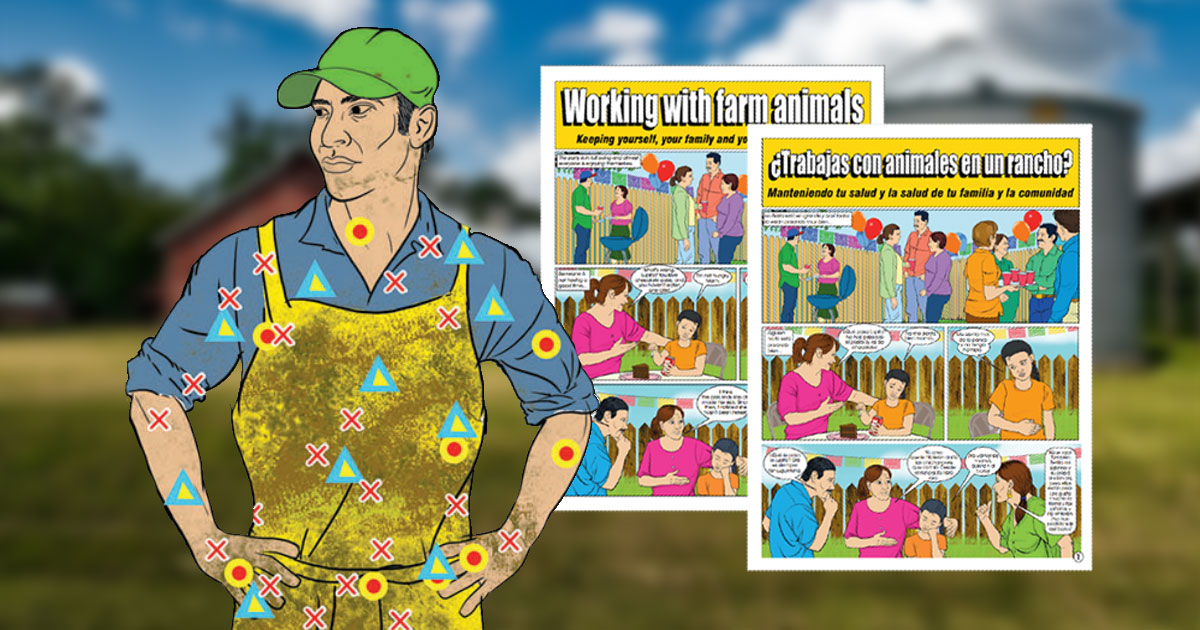
Libro cómic educativo bilingüe sobre cómo prevenir las enfermedades zoonóticas. Desarrollado por MCN en colaboración con la Universidad Estatal de Ohio.
- Working with farm animals_1.pdf (13.33 MB)
- Trabajos con animales en un rancho_1.pdf (13.31 MB)
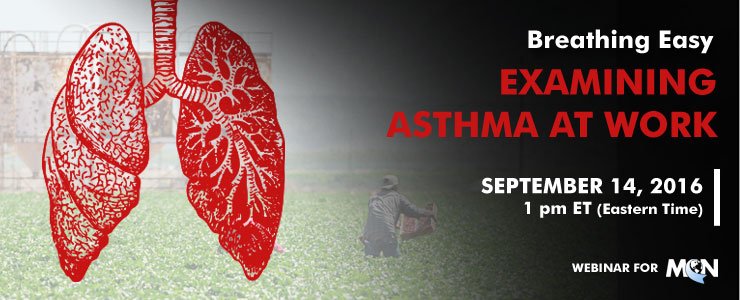
DATE RECORDED: September 14, 2016 at 1 pm ET
PRESENTED BY: Robert Harrison, M.D., M.P.H.
- Recorded Webinar
- Participant Evaluation
- Presentation Slides (PDF)
This material will be produced under grant number SH-27640-15-60-F-48-SH5 from the Occupational Safety and Health Administration, U.S. Department of Labor. It will not necessarily reflect the views or policies of the U.S. Department of Labor, nor does mention of trade names, commercial products, or organizations imply endorsement by the U.S. Government.

DATE RECORDED: September 14, 2016 at 1 pm ET
PRESENTED BY: Robert Harrison, M.D., M.P.H.
This material will be produced under grant number SH-27640-15-60-F-48-SH5 from the Occupational Safety and Health Administration, U.S. Department of Labor. It will not necessarily reflect the views or policies of the U.S. Department of Labor, nor does mention of trade names, commercial products, or organizations imply endorsement by the U.S. Government.
- https://youtu.be/MpNJ-qxL1O0
- http://www.migrantclinician.org/
- https://www.osha.gov/Publications/OSHA3707.pdf
- https://www.thoracic.org/statements/resources/eold/an-official-ats-statement-work-exacerbated-asthma.pdf
- http://journal.publications.chestnet.org/article.aspx?articleid=1044851
- http://www.nj.gov/health/eoh/survweb/wra/documents/asthmagens.pdf
- http://www.ccohs.ca/oshanswers/diseases/asthma.html
- http://www.aoec.org
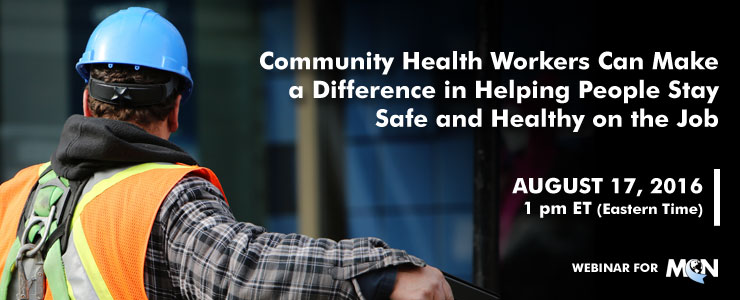
DATE RECORDED: August 17, 2016 at 1 pm ET
PRESENTED BY: Amy Liebman, MPA, MA and Wilson Augustave, member of MCN’s Board of Directors and Senior HIV Case Manager at Finger Lakes Community Health
This material will be produced under grant number SH-27640-15-60-F-48-SH5 from the Occupational Safety and Health Administration, U.S. Department of Labor. It will not necessarily reflect the views or policies of the U.S. Department of Labor, nor does mention of trade names, commercial products, or organizations imply endorsement by the U.S. Government.
- http://migrantclinician.adobeconnect.com/p50hmpih2ti/?OWASP_CSRFTOKEN=3e2b187aeeb1282a41d5df37d8a98c307a7e00006662aca9d5f21dc12aa036c4
- http://www.migrantclinician.org/
- http://workerscomphub.org/
- http://workerscomphub.org/navigating-system
- https://www.osha.gov/workers/index.html
- http://www.coshnetwork.org/know-your-rights
- http://hesperian.org/books-and-resources/
A CDC resource page where there is current Zika updates and resources.
A CDC resource page where there is current Zika updates and resources.
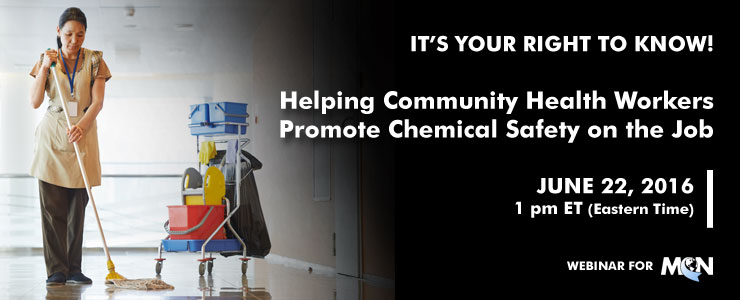
DATE RECORDED: June 22, 2016
PRESENTED BY: Kerry Brennan
This material will be produced under grant number SH-27640-15-60-F-48-SH5 from the Occupational Safety and Health Administration, U.S. Department of Labor. It will not necessarily reflect the views or policies of the U.S. Department of Labor, nor does mention of trade names, commercial products, or organizations imply endorsement by the U.S. Government.
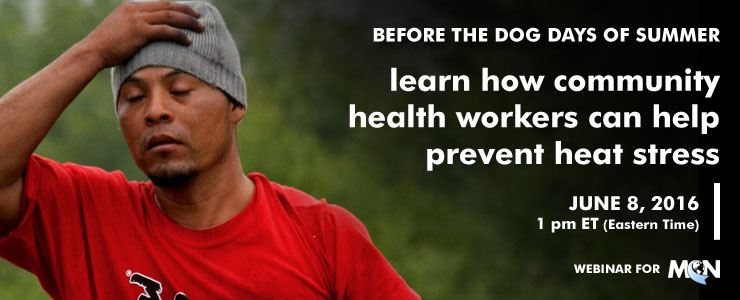
DATE RECORDED: June 8, 2016
PRESENTED BY: Juliana Simmons, MSPH, CHES
This material will be produced under grant number SH-27640-15-60-F-48-SH5 from the Occupational Safety and Health Administration, U.S. Department of Labor. It will not necessarily reflect the views or policies of the U.S. Department of Labor, nor does mention of trade names, commercial products, or organizations imply endorsement by the U.S. Government.
- https://youtu.be/qcCci3GQs04
- http://www.migrantclinician.org/
- https://www.osha.gov/SLTC/heatstress/prevention.html
- http://www.farmworkerjustice.org/sites/default/files/FJpesticidetrainingspanish2016.pdf
- https://www.osha.gov/SLTC/heatstress/index.html
- https://www.osha.gov/SLTC/heatillness/index.html
- https://www.osha.gov/SLTC/heatstress/industry_resources.html
- http://www.dir.ca.gov/dosh/heatIllnessQA.html
- http://www.lni.wa.gov/Safety/Topics/AtoZ/HeatStress/
- http://en.hesperian.org/hhg/Workers%27_Guide_to_Health_and_Safety:Dangers_from_heat
- http://www.naplesnews.com/news/crime/report-farmworkers-death-should-have-been-prevented-2738c212-4e00-109c-e053-0100007fd972-363310521.html
- http://www.cdc.gov/niosh/topics/heatstress/heatrelillness.html

ACA Toolkit:
Available in English and Spanish
Health Insurance Guide:
Available in English and Spanish and Haitian Creole
Older Guides:
Available in English, Spanish, and Haitian Creole for workers on employer-provided health insurance
Created by Farmworker Justice.
- http://www.farmworkerjustice.org/sites/default/files/FJ_ACA_Fact_Sheet_Employer_Provided_Health_Insurance_FINAL.pdf
- http://www.farmworkerjustice.org/sites/default/files/FJ_ACA_Fact_Sheet_Employer_Provided_Health_Insurance_SPANISH_FINAL.pdf
- http://www.farmworkerjustice.org/sites/default/files/FJ_ACA_Fact_Sheet_Employer_Provided_Health_Insurance_CREOLE_FINAL.pdf
http://www.asbestosdiseaseawareness.org/
ADAO is the largest independent nonprofit in the U.S. dedicated to preventing asbestos exposure, eliminating asbestos-related diseases, and protecting asbestos victims' civil rights through education, advocacy, and community initiatives.
http://www.cdph.ca.gov/programs/cosmetics/Pages/default.aspx
An online, searchable database that allows salon workers and others to learn about and report toxic chemicals found in nail salon products and other cosmetics.
"A new issue brief from the National Center for Medical-Legal Partnership shares how medical-legal partnerships operate at health centers and how integrated legal care can help health centers meet their mission."
Migrant Clinicians Network, Inc. (MCN) will work during the next two years to engage members of our clinical network and all relevant stakeholders to advance health justice for the mobile poor. Our advocacy and education priorities focus on safe and legal entry into the United States, as well as strong and equal protection for workers in all occupations. Advancement in these areas creates the greatest opportunity for all to access high-quality, affordable healthcare.
- Comprehensive Immigration Reform
- Access to Health Care
- MCNAdcovacyAgendaFinal.pdf (148.62 KB)
Spanish-language skin cancer outreach materials from the American Academy of Dermatology, which are used during their public skin cancer examinations. Their pilot program providing examinations, targeting Hispanic outdoor workers in California, Arizona, Texas and Florida, was featured in MCN's Streamline, Autumn 2014.
- CCP_Spanish_SpotMe.pdf (2.48 MB)
- Spanish_Sunscreen_Poster.pdf (154.57 KB)
- Spanish_Free_Screening_Poster.pdf (1.23 MB)
- Latino_Outreach_Event_Flyer_2UP.pdf (499.55 KB)
Messages to Millions is designed to provide consistent, science-based Million Hearts® messages to disseminate to partners and supporters on a quarterly basis. Message maps provide key and supporting messages that stress the steps that can be taken by consumers, health care providers, and other audiences to help prevent heart attacks and strokes.
Recently in the UK, there has been research supporting midwifery care. Due to this research, the UK has made some policy changes in regards to maternity. Midwifery care has been shown to be more safe for women with uncomplicated pregnancies and because of these new policies, the United States may follow in their footsteps.
- NICEGuidelinesSummary.pdf (442.38 KB)
These bilingual posters educate workers on how to work safely with machinery on the farm. Developed by two Occupational Health Interns (OHIP) during their internship with the National Farm Medicine Center, these posters accompany the Seguridad en las Lecherías curriculum.
- TractorPosterENG2016.pdf (5.97 MB)
- TractorPosterSPAN2016.pdf (6.03 MB)
Este diccionario ilustrado bilingüe de MCN, "Seguridad en Palabras/ Safety in Words", muestra los peligros que hay en el lugar de trabajo y las mejores prácticas para la salud y la seguridad en la agricultura. Desarrollado con el apoyo del Programa de Subvenciones Susan Harwood de OSHA, este recurso refuerza el vocabulario en inglés de los trabajadores que hablan español lo que ayudará a prevenir lesiones en la agricultura.
Part 5 of the 6 webinar series: Essential Clinical Issues in Migration Health
DATE RECORDED: June 5, 2014
PRESENTED BY: Katherine Brieger, RD and Elizabeth Magenheimer
To receive CME* or CNE credit after viewing any of these webinars you must do the following:
|
Diabetes continues to be one of the most common and challenging health condition confronting migrants and other underserved populations. It is clear that a healthy lifestyle is critical to mitigating the impact of diabetes on individuals and the population, however effective and appropriate interventions can be difficult to design. Fairhaven Community Health Center in Connecticut and Hudson River Healthcare in New York, are two health centers that have long led the way in creating culturally appropriate lifestyle programs for migrants and other underserved patients. In this session the presenters will discuss lessons learned from the development of a variety of programs for diabetics and other patients including a community garden, nutrition classes, cooking classes, weight management and strategies to encourage exercise. The session will address the clinical core measures related to nutrition and BMI and will also discuss current research test second line drug effectiveness in Type 2 DM. Available in English
Learning Objectives:
- Describe culturally appropriate diabetes intervention strategies
- Identify strategies to address clinical core competencies related to nutrition and BMI to improve quality care.
- Receive “take home” examples of how to incorporate effective nutrition, weight loss, exercise and other health lifestyle strategies.
FURTHER READING |
Download the Spanish Toolkit Materials
National Diabetes Information Clearinghouse, http://diabetes.niddk.nih.gov/dm/pubs/preventionprogram Bright Bodies, http://brightbodies.org |
- https://youtu.be/s9tdKcyE5OE
- http://www.cdc.gov/diabetes/ndep/pdfs/16-road-to-health-user-guide-spanish.pdf
- http://www.cdc.gov/diabetes/ndep/pdfs/17-road-to-health-activities-guide-spanish.pdf
- http://www.cdc.gov/diabetes/ndep/pdfs/18-road-to-health-resource-guide-spanish.pdf
- http://www.cdc.gov/diabetes/ndep/pdfs/19-road-to-health-flipchart-spanish.pdf
- http://www.cdc.gov/diabetes/ndep/pdfs/20-road-to-health-physical-activity-quiz-spanish-508.pdf
- http://www.cdc.gov/diabetes/ndep/pdfs/21-road-to-health-city-of-excuses-spanish.pdf
- http://www.cdc.gov/diabetes/ndep/pdfs/22-road-to-health-future-poster-spanish.pdf
- http://diabetes.niddk.nih.gov/dm/pubs/preventionprogram/
- http://diabetes.niddk.nih.gov/dm/pubs/preventionprogram
- http://brightbodies.org/
- http://brightbodies.org
New bilingual resource available April 2014!
Student Action with Farmworkers (SAF) has been using theater as an educational tool with farmworkers for over twenty years. By drawing on techniques of popular theater, SAF performs culturally appropriate, lively skits and facilitates theater workshops at farm labor camps. These performances spur conversations about mental and physical health, living and working conditions, and farmworker movements for social justice.
Many of SAF’s performances have focused on health issues, and they aim for this guide to offer dynamic tools for health care providers, educators, outreach workers, and public health innovators. Practitioners can also use these techniques with other populations across the social justice spectrum. For both organizers and educators, SAF hopes that popular theater can bolster the messages and information that you so readily share and provide a dynamic approach to outreach. Resources include songs, scripts, theater games and icebreakers. Printed copies are free, but SAF accepts small contributions to cover shipping and handling ($5-10/copy).
Available in print and online
Contact: Laxmi Haynes , 919-660-3660
These files are part of the Engaging Migrant Men project.
MCN developed 3 vignettes that portray the three messages developed in video and printed form.
- palabras_BI.pdf (354.68 KB)
- Palabras_SP.pdf (354.01 KB)
- para_BI.pdf (282.97 KB)
- para_SP.pdf (335.13 KB)
- vio 3 topics booklet_BI.pdf (371.19 KB)
- vio 3 topics booklet_SP.pdf (364.91 KB)
- violencia_BI as flyers.pdf (578.78 KB)
- violencia_SP as flyers.pdf (569.02 KB)
These files are part of the Engaging Migrant Men project.
Accompanying discussion guides were created to be used by male peers, community leaders, or outreach workers for one-on-one and small group discussions with men.
Hombres Unidos is a peer-led workshop focused on the primary prevention of sexual and intimate partner violence (s/ipv) with Latino migrant men. Developed in 2005 with the support from the Centers for Disease and Control, this five session workshop is implemented using a popular education technique (Paulo Freire) which is a concept that incorporates notions of class, political struggle and social transformation.
This webinar (sponsored by the Washington Coalition of Sexual Assault Programs) focuses on the collaborative development of a primary prevention workshop for Latino migrant men, the evaluation of the workshop, and the continuing effort on engaging Latino migrant men as allies with women in s/ipv prevention after the five session workshop.
After this webinar, participants will be able to identify:
- methods on how to begin a conversation on sexual and intimate partner violence with Latino migrant men
- process and outcome evaluation techniques on a primary prevention workshop developed for a specific population
- efforts to continue to engage Latino migrant men in sexual and intimate partner violence prevention
- how to incorporate existing efforts with your population
Recording & Materials
During the webinar, Adrian referenced a few handouts that are used in the program. Below you will find a few of these in Spanish.
- http://www.wcsap.org/engaging-latino-migrant-men-violence-prevention-webinar
- http://www.wcsap.org/sites/wcsap.huang.radicaldesigns.org/files/uploads/webinars/Hombres_Unidos/index.htm
- http://www.wcsap.org/sites/wcsap.huang.radicaldesigns.org/files/uploads/trainings_events/recorded_webinars/EngagingLatinoMigrantMenViolencePrevention_10.29.13.pdf
- http://www.wcsap.org/sites/wcsap.huang.radicaldesigns.org/files/uploads/webinars/ContinuumSpanish_EmotionalPsychological.pdf
- http://www.wcsap.org/sites/wcsap.huang.radicaldesigns.org/files/uploads/webinars/WheelSpanish_Equality.pdf
- http://www.wcsap.org/sites/wcsap.huang.radicaldesigns.org/files/uploads/webinars/WheelSpanish_PowerandControl.pdf
Este libro cómic bilingüe a todo color trata la indemnización laboral por accidente, los derechos y responsabilidades de los trabajadores inmigrantes que trabajan en granjas lecheras. Cuenta la historia de un trabajador mexicano de una granja lechera que se lesiona en el trabajo y los pasos que él y su empleador dan para asegurarse de que reciba sus beneficios y la granja mejore su seguridad. Incluye historias aplicables en todo Estados Unidos y otras específicas de cada estado.
- DairyWrkrRightsWrkComp_ENG2016_web.pdf (7.78 MB)
- DairyWrkrRightsWrkComp_ESP2016_web.pdf (7.92 MB)
- COMIC - Safety and Health on the Farm - New Mexico - English.pdf (3.4 MB)
- COMIC - Safety and Health on the Farm - New Mexico - Spanish.pdf (3.41 MB)
- COMIC - Safety and Health on the Farm - New York - English.pdf (3.45 MB)
- COMIC - Safety and Health on the Farm - New York - Spanish.pdf (3.46 MB)
- COMIC - Safety and Health on the Farm -Minnesota -English.pdf (7.78 MB)
- COMIC - Safety and Health on the Farm - Minnesota - Spanish_0.pdf (7.91 MB)
The resources listed below are available from the National Immigration Law Center’s website, www.nilc.org. Each of them is subject to being updated or otherwise revised as new developments warrant. The documents available from the links provided here may be downloaded by individual readers and either printed out or viewed electronically, but electronic copies of the documents MAY NOT BE UPLOADED TO ANY WEBSITE other than NILC’s.
- Overview of Immigrant Eligibility for Federal Programs (see page 4 for a list of “qualified” immigrants) – www.nilc.org/document.html?id=108
- Maps: Health Coverage for Immigrant Children and Health Coverage for Pregnant Women – www.nilc.org/healthcoveragemaps.html
- Medical Assistance Programs for Immigrants in Various States – www.nilc.org/document.html?id=159
- Sponsored Immigrants & Benefits – www.nilc.org/document.html?id=166
- “Lawfully Present” Individuals Eligible under the Affordable Care Act – www.nilc.org/document.html?id=809
- Frequently Asked Questions: Exclusion of Youth Granted “Deferred Action for Childhood Arrivals” from Affordable Health Care –www.nilc.org/document.html?id=802
- A Quick Guide to Immigrant Eligibility for ACA and Key Federal Means-tested Programs – www.nilc.org/document.html?id=844
- Typical Documents Used by Lawfully Present Immigrants – www.nilc.org/document.html?id=35
- Federal Guidance on Public Charge: When Is it Safe to Use Public Benefits? – www.nilc.org/document.html?id=164
- http://www.nilc.org/
- http://www.nilc.org
- http://www.nilc.org/document.html?id=108
- http://www.nilc.org/healthcoveragemaps.html
- http://www.nilc.org/document.html?id=159
- http://www.nilc.org/document.html?id=166
- http://www.nilc.org/document.html?id=809
- http://www.nilc.org/document.html?id=802
- http://www.nilc.org/document.html?id=844
- http://www.nilc.org/document.html?id=35
- http://www.nilc.org/document.html?id=164